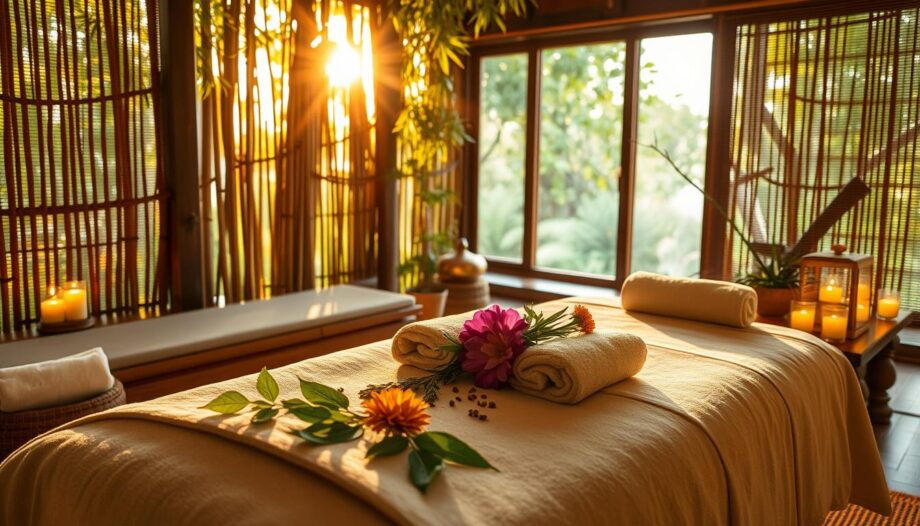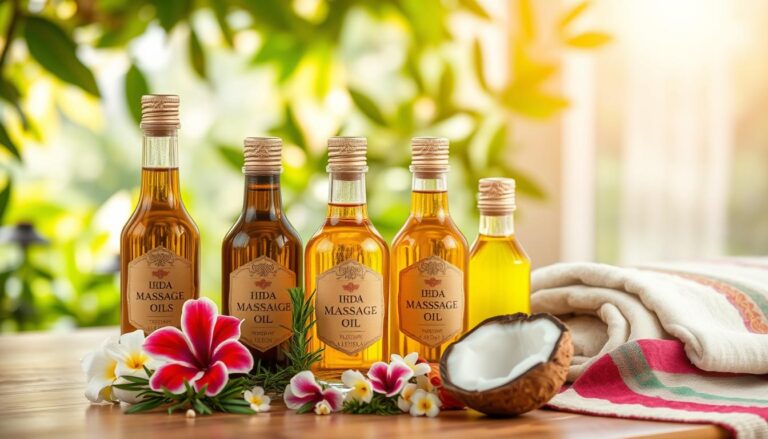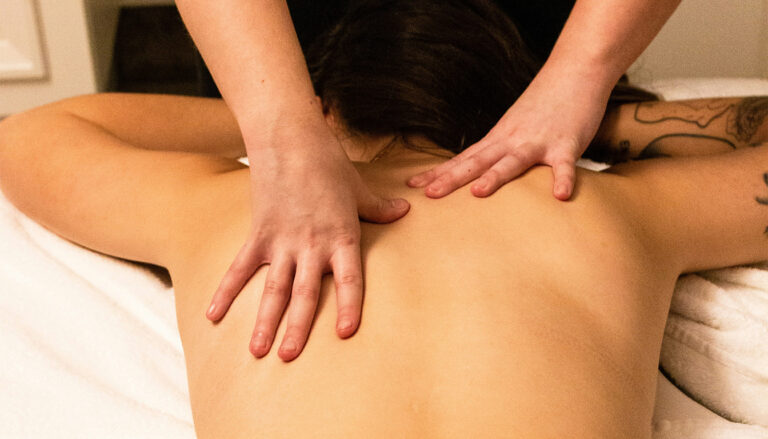Abhyanga is an ancient Ayurvedic practice of full-body oil massage. It’s a key healing method in traditional Indian medicine. This therapy combines massage benefits with the nourishing qualities of special oils. It aims to restore balance and harmony in the body and mind1.
Ayurvedic philosophy focuses on three main life forces: pitta (fire), vata (air and space), and kapha (earth and water)1. Abhyanga aims to balance these doshas. It customises the massage and oil choice for each person’s unique needs. This helps promote well-being, boosts physical and mental strength, and brings deep relaxation and rejuvenation.
Abhyanga is more than a spa treatment; it’s a deep healing practice based on Ayurvedic wisdom. Through the National Ayurvedic Medical Association, you can find certified practitioners. They will help you through this transformative experience1.
Understanding Abhyanga: Ancient Ayurvedic Oil Massage
Abhyanga is an ancient Ayurvedic practice of full-body oil massage. It aims to balance the three doshas: vata, pitta, and kapha2. This ritual uses herbal oils suited to each person’s constitution, boosting overall health. You can get it done by a therapist or do it yourself, making it easy to fit into your daily routine3.
The massage involves long strokes and circular motions with warm, medicated oils4. It offers many benefits, like less stress, better sleep, and improved blood flow2.
| Dosha | Recommended Oils |
|---|---|
| Vata | Plain untoasted Sesame Oil, Mahanarayan Oil |
| Pitta | Sunflower Oil, Coconut Oil, Pitta Massage Oil, Neem Oil |
| Kapha | Herbal oils infused with cooling herbs like waterhyssop, turmeric, lotus root, basil, and cloves |
Ayurvedic wisdom says opposites balance3. So, the oils used in abhyanga depend on your dosha, current balance, and environment3. Adding this ancient self-care to your daily life can change your life, improving your physical, mental, and emotional health3.
“Abhyanga is a time-honoured ritual that nourishes the body, mind, and spirit. It is a sacred act of self-love and care.”
The Therapeutic Benefits of Ayurveda Abhyanga Massage
Ayurvedic abhyanga massage is a self-care practice that benefits the body, mind, and overall well-being. Abhyanga is done for 60 minutes by two therapists, touching over 100 Marma points in the body5. This ancient method helps with physical, mental, and emotional health.
Physical Benefits
Abhyanga reduces muscle stiffness and improves flexibility5. It nourishes the body’s tissues and removes impurities5. It also detoxifies by stimulating the lymphatic system5.
Mental Benefits
Abhyanga calms the nervous system, reducing stress and anxiety6. It helps you sleep better, leading to relaxation and rejuvenation6. It also boosts self-love and self-respect, giving you valuable “you time”6.
Systemic Benefits
Abhyanga improves circulation and organ function5. It also enhances the musculoskeletal and nervous systems5. Studies show it lowers stress, blood pressure, and improves heart rate variability5.
Ayurvedic Abhyanga massage nourishes the body, reduces ageing effects, and boosts well-being5. It calms nerves, improves sleep, and aids detoxification, offering a holistic healing approach6.
“Abhyanga massage stimulates over 100 Marma points in the body, helping to eliminate fatigue, reduce mental stress, and create lymphatic stimulation.”5
- Calms the nerves
- Increases levels of stamina and alertness throughout the day
- Better, deeper sleep at night
- Detox and healthy weight management
- More “you time”
| General Ayurvedic Instructions | Additional Notes |
|---|---|
|
|
Abhyanga massage, rooted in Ayurveda, offers many benefits. It reduces stress5, provides pain relief5, improves skin health5, and aids lymphatic drainage5. This holistic self-care method enhances well-being and deepens self-connection56.
Essential Oils and Their Healing Properties
The choice of oil in Abhyanga, the Ayurvedic self-massage, is key. It depends on your dosha. Vata types need heavy carrier oils like almond or sesame oil7.
Pitta types prefer neutral oils like ghee or sunflower. Kapha types do well with light oils such as safflower or flaxseed.
Herb-infused oils offer extra benefits. They use herbs like waterhyssop, turmeric, and basil7. These dosha-specific oils can be made at home or bought from Ayurvedic suppliers.
| Oil Type | Key Properties | Dosha Balancing |
|---|---|---|
| Sesame Oil (Til Tel) | Potent antioxidants, foundation for Ayurvedic skin treatments | Balances Vata |
| Coconut Oil (Nariyal Tel) | Skin-friendly antioxidants, Vitamin E, suitable for all skin types, beneficial in winters | Balances Pitta |
| Mustard Oil (Sarson Tel) | Heating properties, relaxes stiff muscles, soothes joint pain | Balances Kapha |
| Castor Oil (Arandi Tel) | Versatile, aids in skin moisturization, reduces acne, promotes hair growth, relieves constipation, stimulates immune system | Balances Vata, Pitta, Kapha |
Special herb-infused oils (Taila) like Dhanwantharam Thailam are made for specific needs. They help with muscle cramps and nerve issues7.
789 Abhyanga aims to balance the doshas. It promotes circulation, soothes muscles, and detoxifies the body. It also relieves stress and nurtures tissues for overall health.
Proper Techniques and Application Methods
Ayurvedic Abhyanga massage uses special techniques and a set order to help energy flow and boost health10. It uses warm herbal oils and gentle to moderate pressure. This is for the whole body, focusing on key areas like the head, neck, and feet10.
Massage Strokes
The strokes in Abhyanga aim to wake up the body’s natural rhythms10. Long strokes are used on limbs, and circular motions on joints and sensitive spots10. This mix helps release tension, boosts blood flow, and brings relaxation.
Body Coverage Sequence
The massage starts at the feet and moves up to cover the whole body10. It focuses on key points and areas linked to vital organs, like the head and navel10. This method ensures the whole body is nourished and balanced.
The oils used in Abhyanga are chosen based on the person’s Ayurvedic body type10. Oils like sesame and coconut are used, often with herbs and spices10. The oil should be around 38-42°C (100-108°F) for best results10.
Abhyanga massage aims to boost energy flow in the body, known as prana in Ayurveda10. It helps release blockages and brings balance and harmony to the body and mind10.
Using these techniques and methods, Abhyanga massage offers many physical, mental, and spiritual benefits10.
Self-Practice Guidelines for Daily Abhyanga
Adding self-abhyanga to your daily routine can bring many benefits. It involves warming oil, applying it to your body with special strokes, and letting it soak in for 10-15 minutes11. The massage time can vary from 5 to 15 minutes11.
Ayurvedic advice suggests how often to do self-abhyanga. Vata types should do it 4-5 times a week12. Pitta types should aim for 3-4 times a week12. Kapha individuals should do it 2-3 times a week12. Doing it daily is best for the best results.
After the massage, take a warm shower or bath to remove excess oil11. Don’t scrub hard or use too much soap, as it can remove the oil’s benefits11. Let the oil soak into your skin for 5-10 minutes before washing off11.
Self-abhyanga can change your daily routine for the better. By following these tips, you can enjoy many physical, mental, and systemic benefits. Start this self-care ritual and feel the deep healing of Abhyanga.
Contraindications and Safety Considerations
Ayurvedic abhyanga massage is great for many health benefits, but it’s important to know when to avoid it13. You should not do abhyanga after eating, if you have a bad headache, or if you’re feeling very congested13. It’s also not good during severe constipation, early fever, or right after surgery13. And, it’s best to skip it during the first three days of your period or if you’re experiencing heavy bleeding13.
Medical Conditions
If you have certain health issues, talk to a doctor before trying abhyanga13. People with skin problems, broken bones, or chronic illnesses like anxiety or high cholesterol should be careful14. Ayurvedic treatments can help, but you need to think about side effects and how they might interact with your medicines14.
Special Circumstances
Don’t do abhyanga after certain treatments like emetics or basti, as it might undo their effects13. Also, if you have a health issue and haven’t talked to a doctor about it, it’s best to avoid abhyanga13.
Knowing when not to do Ayurvedic abhyanga massage is key to using it safely and effectively13. Talking to an Ayurvedic expert or doctor can help figure out what’s best for you14.
| Condition | Contraindication |
|---|---|
| After Eating | Avoid |
| Severe Headache or Migraine | Avoid |
| Excessive Mucus or Congestion | Avoid |
| Severe Constipation | Avoid |
| Early Stages of Fever | Avoid |
| Directly After Surgery | Avoid |
| First 3 Days or Heavy Menstrual Flow | Avoid |
| Skin Infections | Consult a Healthcare Provider |
| Broken Bones | Consult a Healthcare Provider |
| Chronic Illnesses | Consult a Healthcare Provider |
“Consulting with a qualified Ayurvedic practitioner or healthcare provider can help individuals determine the appropriate course of action for their specific needs and circumstances.”14
Conclusion
Abhyanga, the ancient Ayurvedic oil massage, is a powerful holistic practice. It offers many healing benefits for the body, mind, and spirit. By adding this ancient technique to daily routines, people can see better health, less stress, and more personalised wellness15.
But, it’s key to think about your unique dosha types. Also, talking to a skilled Ayurvedic practitioner is important. They can help pick the right oils and approach for you16. Following the right techniques and safety rules is vital to get the most from this natural therapy17.
By making Abhyanga part of an Ayurvedic lifestyle, you start a journey towards complete healing and better health. This ancient practice helps find balance, energy, and a closer bond with nature’s rhythms151617.
FAQ
What is Abhyanga?
Abhyanga is a healing practice from Ayurveda, an ancient Indian medicine. It’s a full-body massage with warm oil, from scalp to feet. It aims to improve health and wellness.
What are the Ayurvedic principles behind Abhyanga?
Abhyanga follows Ayurvedic principles. It balances the three doshas: vata, pitta, and kapha. It uses herbal oils based on individual constitutions.
What are the therapeutic benefits of Abhyanga?
Abhyanga has many benefits. It reduces muscle stiffness and improves flexibility. It also enhances skin health and reduces stress.
It improves sleep, boosts energy, and increases circulation. It also helps with lymphatic drainage and supports the musculoskeletal and nervous systems.
How are the oils chosen for Abhyanga?
Choosing the right oil for Abhyanga is key. Vata types need heavy oils like almond or sesame. Pitta types prefer neutral oils like ghee or sunflower.
Kapha types benefit from light oils like safflower or flaxseed. Herb-infused oils offer extra benefits.
What are the techniques and application methods for Abhyanga?
Abhyanga uses specific massage strokes and a systematic approach. Long strokes are used on limbs, and circular motions on joints and tender areas.
The massage starts at the feet and moves up, covering each part systematically.
How can I incorporate Abhyanga into my daily routine?
You can add Abhyanga to your daily routine. Warm 1/4 to 1/2 cup of oil. Apply it to your body using specific strokes.
Let it absorb for 10-15 minutes for the best benefits.
Are there any contraindications or safety considerations for Abhyanga?
Abhyanga is not suitable for everyone. It’s not recommended after eating, during severe headaches or migraines, or with excessive mucus or congestion.
It’s also not good for severe constipation, early stages of fever, or directly after surgery. Avoid it during the first three days or heavy menstruation.





